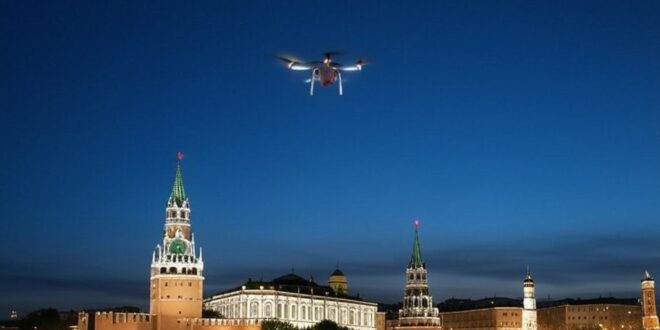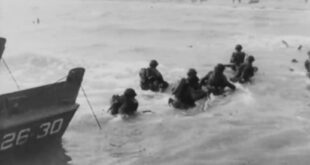by Mike Eckel, RFE/RL
Prior to May 3, the last time the Kremlin was attacked — bombed, in fact — was in 1942, when Nazi forces were closing in on Moscow. Before that, you’d have to go back to Napoleon, when French forces entered the Kremlin, albeit without much of a fight.
Now add to the list a pair of mysterious, dead-of-night drone flights that set the roof of one Kremlin building partly ablaze, just days before President Vladimir Putin hosts the Kremlin’s most prominent annual spectacle: the Red Square military parade commemorating the defeat of Germany in World War II.
More than 24 hours after the incident, caught on surveillance videos, the questions of who was behind the drone flights — and what was the goal — remain shrouded in mystery and wartime obfuscation.
READ MORE from Soldier of Fortune: Kremlin Says No One Tried to Kill Putin This Week
The Kremlin has blamed Ukraine, accusing it of trying to assassinate Putin, who was not even on the premises at the time, according to his press service. Ukrainian officials, including President Volodymyr Zelenskiy, denied involvement, while also suggesting that Russia itself could have staged the incident as a “false flag,” a pretext to escalate the war in Ukraine.
And if Ukraine did in fact pull off the incident, it would be a major embarrassment for Russian military and air defenses, particularly coming less than a week before the Victory Day parade just outside the Kremlin.
“Let’s be clear on what this is not,” said James Nixey, who heads the Russia and Eurasia Program at Chatham House, a London-based think tank. “It’s not an assassination attempt on Vladimir Putin. That’s just what the Kremlin is saying.”
“The two most likely possibilities are a ‘warning shot across the bows’ by Kyiv – ‘look what we can do’— or a false-flag operation by Moscow designed to justify more intense attacks in Ukraine or more conscription,” he told RFE/RL.
The flight of the drones, which occurred 16 minutes apart, at around 2:30 a.m., was captured on several surveillance videos, at least one of which may have been controlled by the Russian security services.
One video showed part of the doomed roof of the Senatsky Dvorets, the Senate Palace that overlooks Red Square, set ablaze. Other videos showed a flying object moving toward the dome, as several people climbed a rooftop ladder, before the object exploded near a flagpole on the roof.
There were no injuries, the Kremlin said, and damage to the building appeared to be minimal.
The Kremlin, which issued its first statement about 12 hours after the incident, claimed that it was an assassination attempt against Putin by “the Kyiv regime,” and that air defenses had brought down the objects. Kremlin spokesman Dmitry Peskov later cast blame not only on Ukraine, but also the United States, which denied involvement.
“We know very well that the decision for such actions and terrorist attacks are made not in Kyiv, but in Washington,” Peskov told reporters on May 4, providing no evidence.
Ukraine has repeatedly denied launching attacks on Russian soil. “We don’t attack Putin or Moscow. We fight on our territory. We are defending our villages and cities,” Zelenskiy said during a visit to Helsinki on May 4.
However, Ukraine appears to have been waging a covert, low-level campaign within Russia for months, using drones and possibly special forces to strike things like fuel depots and pipelines.
A Russian air base that is home to strategic bombers and located hundreds of kilometers from the Ukrainian border has been attacked twice.
Russia’s military has claimed to have shot down drones in the airspace in and around Moscow. Russian ships and other targets in and around occupied Crimea, where Russia’s Black Sea Fleet is based, have been hit repeatedly, including in recent days.
A Ukrainian drone hit a fuel depot in Sevastopol early this morning. pic.twitter.com/q6naijS3v8
— Mike Eckel (@mikeeckel.bsky.social) (@Mike_Eckel) April 29, 2023
A fire that erupted at a refinery in the southern Rostov region late on May 3 was the third apparent drone strike on a Russian depot in two days.
Mykhaylo Podolyak, a top adviser to Zelenskiy, suggested the May 3 drone incident could allow Russia to justify targeting civilian sites in Ukraine. He also alleged that “guerrilla activities of local resistance forces” could be responsible for drones flying within Russia.
“Something is happening in [Russia], but definitely without Ukraine’s drones over the Kremlin,” Podolyak said in a post to Twitter.
‘Performative Strike’
Most experts concluded that it was highly unlikely that the incident was an assassination attempt on Putin: The Russian leader rarely spends the night at the Kremlin, preferring to stay at the official state residence in the suburb of Novo-Ogaryovo, or at an opulent Black Sea palace in Sochi.
If Ukrainians were responsible, however, it would be a massive embarrassment, a stunning breach of Russian security and air defense reminiscent of the 1987 incident when a German teenager, Mathias Rust, landed a light propeller plane directly on Red Square.
“If we presume it was a Ukrainian attack, consider it a performative strike, a demonstration of capability and a declaration of intent: ‘don’t think Moscow is safe’,” Mark Galeotti, a longtime expert on Russian security services, said in a post to Twitter.
Baza, a Telegram channel believed to have links to Russian law enforcement, cited unnamed officials as saying the drones had been reported by people in the Moscow region, but defense officials did not take the reports seriously until the drones were in Moscow airspace, and then it was too late to respond.
“If…Kyiv did it, then it’s yet another shocking security lapse by the Russian state,” Nixey said.
Another violent incident inside Russia that Moscow has blamed on Ukraine was the assassination of Darya Dugina, the daughter of a far-right imperialist philosopher Aleksandr Dugin. She was killed last August when a bomb detonated under the car she was driving outside Moscow.
Ukraine denied involvement in that case, but U.S. intelligence officials told The New York Times they believed that unnamed officials in the Ukrainian government were responsible.
Ukrainian officials have reportedly plotted to attack Moscow directly. The Washington Post last month cited leaked U.S. intelligence reports saying that Ukrainian military intelligence chief Major General Kyrylo Budanov wanted to stage “mass attacks” on Moscow and elsewhere on the anniversary of Russia’s February 24, 2022 invasion.
U.S. officials, however, persuaded Budanov to not go through with the plan, the report said.
‘A Shaker Of Salt’
Officials in Washington said the United States had no advance warning of plans for such an attack. The White House said it couldn’t confirm the reports, but spokeswoman Karine Jean-Pierre said that the United States was not pushing Ukraine to launch attacks on foreign soil.
“Since the beginning of this conflict, the United States is certainly not encouraging…or enabling Ukraine to strike beyond its borders,” she told reporters on May 3.
White House national-security spokesman John Kirby denied any U.S. involvement, saying that Peskov was “just lying” when he pointed the finger at Washington. And U.S. Secretary of State Antony Blinken cast doubt on the Kremlin’s assertion that it was a Ukrainian plot to kill Putin.
“I would take anything out of the Kremlin with a very large shaker of salt,” he told Washington Post columnist David Ignatius.
The Kremlin’s initial public statement on the incident was threatening: “The Russian side reserves the right to take retaliatory measures where and when it sees fit.”
That fueled speculation that it might have been a Russian-orchestrated “false flag” incident, aimed at creating a pretext to take more, or new, actions against Ukraine. Dmitry Medvedev, the former president who is now a rabid advocate for the war on Ukraine, called for the “physical elimination” of Zelenskiy.
“A terrorist attack on the president. This is an attack on Russia,” Vyacheslav Volodin, a close Kremlin ally who heads the lower house of parliament, wrote on Telegram.
Overnight, Russia launched the latest in a series of missile and drone attacks on Kyiv and the Black Sea port of Odesa. And Russian rockets battered the southern city of Kherson, hitting a train station and a shopping mall, killing at least 23 people and injuring dozens more.
“How would you respond to the attack on the Kremlin?” Kremlin-allied political analyst Sergei Markov asked in a post, raising the option of attacking the Pentagon, using tactical nuclear weapons, or targeting Zelenskiy directly.
Since the Soviet collapse, there’s been at least one other incident whose circumstances have long been scrutinized as a possible “false flag”– the 1999 apartment building bombings that led to the Second Chechen War, and, many Russian experts and activists say, cleared the path for Putin to become president months later.
“If it’s Moscow and a false flag, then it reeks of desperation,” Nixey said. “And it’s a high-risk strategy likely to be exposed, considering how poor their tradecraft seems to be.”
Prepare For The Offensive
Along with the drone incident, the uptick in border-region explosions and even the apparent sabotage of railroad trains, comes amid growing anticipation about a planned Ukrainian counteroffensive against Russian forces in eastern or southern Ukraine.
Coming after a grinding winter with both sides pummeling each other and making little tangible progress, the counteroffensive could be a major inflection point in the 15-month conflict, with Ukraine desperate to show its Western allies that it’s still capable of punching Russia hard — and the West should keep the weapons flowing.
Mike Eckel is a senior correspondent reporting on political and economic developments in Russia, Ukraine, and around the former Soviet Union, as well as news involving cybercrime and espionage. He reported on the ground on Russia’s invasion of Ukraine, the wars in Chechnya and Georgia, and the 2004 Beslan hostage crisis, as well as the annexation of Crimea in 2014. Find him on Twitter at [email protected]
 Soldier of Fortune Magazine The Journal of Professional Adventurers
Soldier of Fortune Magazine The Journal of Professional Adventurers






